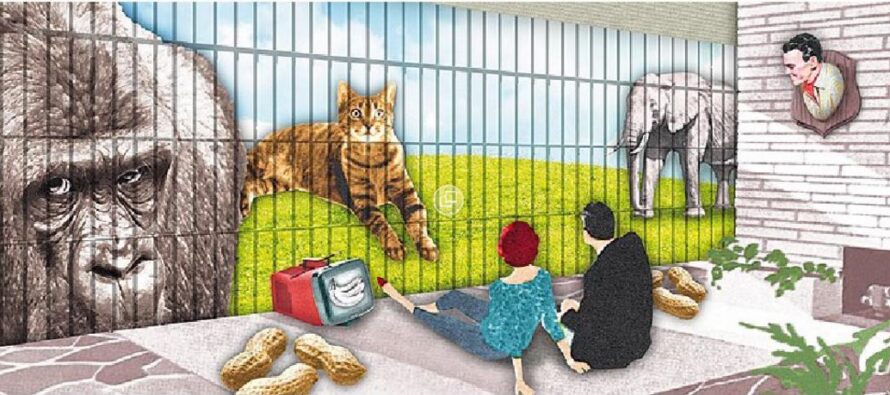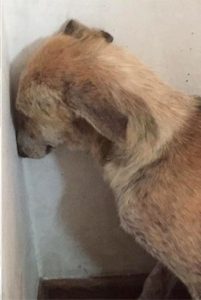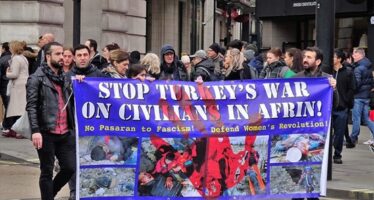ANIMAL RIGHTS – ? – ANIMAL WRONGS

![]()

“To end tyranny we must first understand it.”
Peter Singer, (‘Animal Liberation’)
I think about “rights” frequently. And wrongs, unfortunately, more often.
Anyone who lives in the new dark-ages of contemporary civilisation with a mind that functions and a heart struggling to find its humanity must eventually be driven in this direction.
This darkness – war, hunger, violence, abuse, exploitation, torture, cruelty, is pervasive despite the many oases that the minority of humans on a global basis find shelter in. Despite our skill in looking the other way. Despite our struggle, in each age, to put an end to it.
It is to this oppression and darkness that the 1948 Declaration of Human Rights addressed itself following the Nazi Holocaust:
“Whereas recognition of the inherent dignity and of the equal and inalienable rights of all members of the human family is the foundation of freedom, justice and peace in the world,
Whereas disregard and contempt for human rights have resulted in barbarous acts which have outraged the conscience of mankind, and the advent of a world in which human beings shall enjoy freedom of speech and belief and freedom from fear and want has been proclaimed as the highest aspiration of the common people,
Whereas it is essential, if man is not to be compelled to have recourse, as a last resort, to rebellion against tyranny and oppression, that human rights should be protected by the rule of law…”[1]
This struggle against darkness and oppression is also the work of History, meaning, it has been going on a long time and will continue until we as a species-among-species either manage to destroy ourselves along with our power to organise all life on this small planet, or…?
Recently though, facilitated by modern technology and its ‘social media tools’ which bring us together within this new ‘collective’ and with an enormous deluge of information to share, I am coming to realise that there is a massive amount of knowledge on cruelty – not just on the many human victims of war and human violence – but, in our complex and colonised world, the violence and cruelty that is perpetrated on our more vulnerable neighbours and sometimes-friends – that is, yes…animals.
The notorious killing of ‘Cecil the Lion’ by Mr. Walter Palmer, the American dentist and ‘recreational game hunter’ in July 2015 got international attention.
However, the amount of less ‘famous’ or less mainstream-media-disseminated data that is being circulated by concerned citizens is disturbing. Not least because it highlights the main realm of this darkness – our own ignorance – where, it seems, we reside quite comfortably.
It needs to be said – in particular when we talk of cruelty as it penetrates to the depths of the human heart – it was and is easier to live in a ghetto of ignorance and denial. That way we can convince ourselves no matter what excesses or aberrations, that we are still, as a species, and individually, you and me, fundamentally, human, kind, caring…
If only…if fucking only…
But now…in this world where the lights never go off – “online 24/7”, we have the opportunity to become public witnesses to the pornography that human cruelty – this dark side of our potential to be human – seems to wallow in and on a daily basis…sometimes for economic reasons but more often from some ‘sinister’ throwback – some reptilian brainstem of an impulse that severely limits our potential and our presence in the world to a so called ‘primitive’ impulse to be cruel, to hurt and to take pleasure in another creature’s suffering, instead of its opposite.
Say it again. To be cruel. To hurt. To torture. And to take pleasure in another creature’s suffering. And when we don’t have a war with which to exercise the impulse, look around, where is there a more vulnerable victim available?
Cruelty perpetrated on animals by humans has to be the greatest kept ‘secret’ on the planet since the ending of the last ice-age approximately 150,000 years ago. Before then, the animals had a chance, to escape, to fight back, to win, at least some of the time, but now..?
One example, (check the video links below) early each summer, is the Yulin Dog Meat festival, an annual ‘celebration’ held in Yulin, Guangxi, China, during the summer solstice. Words don’t really capture what we are talking about here – at least to someone who has had an opportunity to nurture the human heart. Take a look online and you might understand what I am trying to say[2]:
“The Yulin Dog Meat Festival, which happens every year on the summer solstice, is a particularly gruesome display of the dog meat trade. This “festival”, where some 10,000 dogs are slaughtered and served up as meals. These thousands of dogs are beaten, killed, and eventually eaten by people who believe eating dog meat on this day will bring good luck.”[3]
…That 4,675,932 people across the world protested against the 2016 Festival this year – STOP THE YULIN DOG MEAT EATING FESTIVAL – via a petition which was delivered to the Governor of Yulin GuangXi Province China – Mr. Chen Wu and the Chinese Minister of Agriculture, notwithstanding.[4]
Or the recently failed campaign here in Ireland to stop hare coursing:
“Hare coursing involves the terrorising of one animal by another and is full of unnecessary cruelty and killing. Two forms of coursing are practiced in Ireland – enclosed coursing and open coursing. Both involve the use of a hare as a live lure. Every year, coursing subjects thousands of hares to stress, injury and death.”[5]
In the recent Dáil (Parliament) vote of 164 public representatives, to the country’s shame, 114 voted for this barbaric practice (surely not a ‘sport’ ?) – including the new opposition party, Sinn Féin, with its revolutionary promise of “building a new republic” – and only 20 against at the end of June,
This is in contrast to Scotland where on August 11 this year:
“A hare courser has become the first person in Scotland to be jailed using DNA evidence taken from a hunting dog…Detective chief superintendent Sean Scott, of Police Scotland’s specialist crime division, said: ‘Hare coursing where dogs chase the animal is a particularly violent crime. Public awareness is crucial in helping us tackle crimes like poaching and hare coursing.'”[6]
Or what about the different Bull Runs in Pamplona and other Spanish, Portugese, Mexican and French towns and cities:
“It hurts me to say it but the Spanish are a savage, insensitive and ignorant people,” says Miguel Ángel Rolland. In his new documentary, the Spanish film-maker has chronicled some of the 16,000 religious festivals across Spain that he says involve the torture of animals.”[7]
And on and on and on…
This morning, coming out of the dream that helps me recover physically and mentally from my stressful night-work I saw a photograph posted of what had been described as ‘Pressed Head Syndrome”.
In the picture a sad and beaten looking greyhound is trying to hide her head against a wall:
“In it, the dog, barely a year old, presses his (sic) head against the wall to avoid looking at humans. According to animal behaviourists, the dog thinks that if he can’t see you, you can’t see him and so you won’t be able to hurt him again.”
The picture comes from a video released by Paws Animal Rescue in Ireland in July 2015.[8]
“As soon as she arrived, she found the nearest corner and buried her face against the wall and wouldn’t move. It was clear that whatever had happened to her in her short lived life, had so badly traumatised her, she couldn’t even bare to move or look at her surroundings. Some dogs, when they first arrive in PAWS, almost get the sense that they are finally in safe hands….But, for this little lurcher girl, it was evident that all she wanted to do was disappear.”[9]
Niamh Walsh writing at the time:
“Ireland’s record on animal cruelty is such that you can beat, starve or torture defenceless animals to death, breed them to exhaustion, use them as live bait for dog fights, all safe in the knowledge that even if you are caught, you won’t spend a second behind bars.”[10]
She was referring, not just to the PAWS video but to a 2015 court appearance. Her article:
‘Ireland should hang its head in shame’ describes how :
“…on Tuesday, a father who swung his pet dog overhead by its lead and smashed its tiny body 30 times into the ground in a public park walked free from a court in Dublin. Liam Dowling walked free from court after beating a dog to death in a Dublin park. Judge Martin Nolan could have jailed Liam Dowling for up to five years but instead intends imposing 200 hours’ community service on the basis he is a suitable candidate – yet Dowling has 12 prior convictions including a four-and-a-half-year sentence for a drugs offence…Worse still, he refused to ban him from owning animals.”
Reflecting on this article I summarised that the list of human cruelty to animals – is almost endless:
There is, for example: the fur trade, seal clubbing, animal testing & animal experimentation (in 2010 an estimated 100 million animals were used annually, alongside the cosmetics industry, by “universities, medical schools, pharmaceutical companies, defense establishments, and commercial facilities that provide animal-testing services to industry”)[11], dolphin and whale slaughter, shooting kangaroos for dog food, medical use of animals, use of animals as food, conditions in slaughterhouses, so called sporting and recreational use of animals, breeding, puppy farms, use/misuse of animals in films, zoos, dog fighting, the cat & dog meat trade in Asia, practices of cruelty in factory farming, abuse of greyhounds in greyhound racing, fox and mink hunting, cock fighting, animal export practices, cruel animal overpopulation controls, Spanish festivals involving the terrifying & torturing to death of innocent animals, badger snaring by the Irish Department of Agriculture (an estimated 120,000 badgers slaughtered painfully in the last 30 years[12]), pet abandonment, the ivory trade…Mr. Dowling the convicted Drug-Dealer beating a dog to death in a Dublin park, Mr. Palmer, dentist from Minneapolis, killing an innocent lion for amusement, and on and on…endlessly…
Right down to Irish pest control companies trapping & killing abandoned cats…[13]
“Angel’ the luckily rescued dog with the ‘pressed head syndrome’ in the picture had a happy ending in being cared for and eventually finding a home outside the shelter. But that, unfortunately, is not always, or even statistically I would imagine, the normal situation.
Cruelty is often a crime (but not always) that is done to others, including other species, but it is also a practice that dehumanises the perpetrator.
For example, studies have established links between interpersonal violence, violence directed at humans and animal cruelty…[14]
In a similar vein, Paulo Freire opens his book Pedagogy of the Oppressed[15]:
“Within history, in concrete, objective contexts, both humanization and dehumanization are possibilities for a person as an uncompleted being conscious of their incompletion.”
“But while both humanization and dehumanization are real alternatives, only the first is the people’s vocation. This vocation is constantly negated, yet it is affirmed by that very negation. It is thwarted by injustice, exploitation, oppression, and the violence of the oppressors: it is affirmed by the yearning of the oppressed for freedom and justice, and by their struggle to recover their lost humanity.”
If only this was the case, that is, that there is a historical imperative that we will eventually learn how to be human, meaning all cruelty and violence will be recognised as inhuman or less-than-human, not just the worst excesses as appears to be the case today…
In the meantime becoming more and more aware, through these new and popular media, that this cruelty and the dehumanisation that it arguably reinforces, is ongoing on a daily basis: must raise the question to those committed to a culture of liberation:
do we need to extend the work of human liberation and freedom we struggle for to the animal world and to all our human relationships and in particular our relationship to other non-human creatures?
Animal Rights – Animal Wrongs – Animal Liberation?
Wikipedia (quoting Taylor, 2009 and Rowland, 1998) defines animal rights as:
“Animal rights is the idea that some, or all, non-human animals are entitled to the possession of their own lives and that their most basic interests—such as the need to avoid suffering—should be afforded the same consideration as similar interests of human beings.”
Likewise the animal rights movement:
“The animal rights movement, sometimes called the animal liberation movement…is a social movement which seeks an end to the rigid moral and legal distinction drawn between human and non-human animals, an end to the status of animals as property, and an end to their use in the research, food, clothing, and entertainment industries.”[16]
In 1975, the Australian philosopher, Peter Singer wrote: Animal Liberation: A New Ethics for Our Treatment of Animals:
In his Preface to the 1975 Edition of this inaugural statement of the current animal liberation movement, he writes:
Peter Singer:
“This book is about the tyranny of human over nonhuman animals. This tyranny has caused and today is still causing an amount of pain and suffering that can only be compared with that which resulted from the centuries of tyranny by white humans over black humans. The struggle against this tyranny is a struggle as important as any of the moral and social issues that have been fought over in recent years.”
40 years later, (in a reissue of the book in 2015), he went on to say:
“In many parts of the world, including Europe and the United States, there has been a huge shift in attitudes toward animals. The powerful animal advocacy movement I hoped would emerge does exist, and thanks to undercover videos and the Internet, the information it provides cannot be denied or suppressed.”
Wikipedia says:
“In Animal Liberation, Singer argues against what he calls speciesism: discrimination on the grounds that a being belongs to a certain species. He holds the interests of all beings capable of suffering to be worthy of equal consideration and that giving lesser consideration to beings based on their species is no more justified than discrimination based on skin color. He argues that animals rights should be based on their capacity to feel pain more than on their intelligence. In particular, he argues that while animals show lower intelligence than the average human, many severely intellectually challenged humans show equally diminished, if not lower, mental capacity and that some animals have displayed signs of intelligence (for example, primates learning elements of American sign language and other symbolic languages) sometimes on a par with that of human children. Therefore, intelligence does not provide a basis for giving nonhuman animals any less consideration than such intellectually challenged humans.”[17]
Speciesism is defined as: “…the assignment of different values, rights, or special consideration to individuals solely on the basis of their species membership. The term is sometimes used by animal rights advocates, who argue that speciesism is a prejudice similar to racism or sexism, in that the treatment of individuals is predicated on group membership and morally irrelevant physical differences. Their claim is that species membership has no moral significance.”[18]
Peter Singer:
“Speciesism—the word is not an attractive one, but I can think of no better term—is a prejudice or attitude of bias in favor of the interests of members of one’s own species and against those of members of other species…If possessing a higher degree of intelligence does not entitle one human to use another for his or her own ends, how can it entitle humans to exploit nonhumans for the same purpose?..
…Most human beings are speciesists….ordinary human beings—not a few exceptionally cruel or heartless humans, but the overwhelming majority of humans—take an active part in, acquiesce in, and allow their taxes to pay for practices that require the sacrifice of the most important interests of members of other species in order to promote the most trivial interests of our own species.”
American animal-rights organisation People for the Ethical Treatment of Animals (PETA) current President Ingrid E. Newkirk says, in her review of the 2015 edition of Singer’s book:
Ingrid E. Newkirk:
“I had been working in animal protection for 10 years in Washington, D.C., as a deputy sheriff, cruelty investigator, and head of the animal-disease-control division of the D.C. Commission on Public Health. I had witnessed appalling acts of cruelty to animals and I would cry as I drove home at night. I still ate meat and wore leather, as I had yet to make that connection, but I was plagued by an underlying sense that there was something inherently wrong with how animals were so easily subjugated and abused.
After reading Animal Liberation, I realized that in the same way that racist and sexist views allowed us to discriminate against minorities and women, speciesism allowed us to inscribe an inferior status on animals and to regard them not as individuals, but as objects and means to fulfill our desires.”[19]
PETA gained notoriety in the summer of 1981, through the undercover work of Alex Pacheco[20] during what became known as the Silver Spring monkeys case, a widely publicised dispute about the cruelty involved in experiments conducted on 17 macaque monkeys inside the Institute of Behavioral Research in Silver Spring, Maryland.[21]
“Today it focuses on four core issues—opposition to factory farming, fur farming, animal testing, and animals in entertainment. It also campaigns against eating meat, fishing, the killing of animals regarded as pests, the keeping of chained backyard dogs, cock fighting, dog fighting, and bullfighting…”
PETA’s review of the 40th anniversary edition of Animal Liberation, includes a number of extracts from Singer’s book which I believe are worth quoting and reading at length if we are to begin to understand how someone can inflict the pain and cruelty witnessed in Yulin or represented in the ‘pressed head syndrome’ of Angel the abused lurcher:
Peter Singer:
“In a forward-looking passage written at a time when black slaves had been freed by the French but in the British dominions were still being treated in the way we now treat animals, Bentham wrote:
Jeremy Bentham[22]:
“The day may come when the rest of the animal creation may acquire those rights which never could have been withholden from them but by the hand of tyranny. The French have already discovered that the blackness of the skin is no reason why a human being should be abandoned without redress to the caprice of a tormentor. It may one day come to be recognized that the number of the legs, the villosity of the skin, or the termination of the os sacrum are reasons equally insufficient for abandoning a sensitive being to the same fate. What else is it that should trace the insuperable line? Is it the faculty of reason, or perhaps the faculty of discourse? But a full-grown horse or dog is beyond comparison a more rational, as well as a more conversable animal, than an infant of a day, or a week or even a month, old. But suppose they were otherwise, what would it avail? The question is not, Can they reason? nor Can they talk? but, Can they suffer?”
Peter Singer:
“In this passage, Bentham points to the capacity for suffering as the vital characteristic that gives a being the right to equal consideration. … If a being suffers, there can be no moral justification for refusing to take that suffering into consideration. No matter what the nature of the being, the principle of equality requires that [his or her] suffering be counted equally with the like suffering—insofar as rough comparisons can be made—of any other being. …”[23]
In these arguments for and against ‘speceism’ and its impact on the way we treat non-human-animals, the thoughts, attitudes, and behaviour of our fellow citizens take shape in a philosophical discourse.
“It has been said that the modern animal rights movement is the first social reform movement initiated by philosophers.”[24]
Richard Rorty, the American philosopher (1931–2007), quoted in Wikipedia says:
Richard Rorty:
‘Such people are morally offended by the suggestion that they should treat someone who is not kin as if he were a brother, or a nigger as if he were white, or a queer as if he were normal, or an infidel as if she were a believer. They are offended by the suggestion that they treat people whom they do not think of as human as if they were human. When utilitarians tell them that all pleasures and pains felt by members of our biological species are equally relevant to moral deliberation, or when Kantians tell them that the ability to engage in such deliberation is sufficient for membership in the moral community, they are incredulous. They rejoin that these philosophers seem oblivious to blatantly obvious moral distinctions, distinctions that any decent person will draw.’
Much of humanity is similarly offended by the suggestion that the moral community be extended to nonhumans.”[25]
Peter Singer:
“Only by making a radical break with more than two thousand years of Western thought about animals can we build a solid foundation for the abolition of this exploitation.”[26]
On May 5, 2015, the New Zealand Parliament unanimously passed the Animal Welfare Amendment Act (No. 2) 2015, which includes an amendment to the long title of the principal legislation, the Animal Welfare Act 1999, in order to specifically recognize animals as sentient. [27]
Dr. Virginia Williams (chair of the NZ National Animal Ethics Advisory Committee):
“To say that animals are sentient is to state explicitly that they can experience both positive and negative emotions, including pain and distress…The explicitness is what is new and marks another step along the animal welfare journey.”[28]
Other countries that have passed animal sentience laws include France and Austria. India has declared whales and dolphins sentient. “In 1997 the concept of animal sentience was written into the basic law of the European Union. The legally binding protocol annexed to the Treaty of Amsterdam recognizes that animals are ‘sentient beings’, and requires the EU and its member states to ‘pay full regard to the welfare requirements of animals’.[29]
The Cambridge Declaration on Consciousness, drawn up by an international group of scientists on July 7, 2012, confirmed that many animals, including all mammals and birds, possess the “neurological substrates that generate consciousness”.[30] …Meaning the human-animals in this larger animal kingdom we share, are not the only ones to possess consciousness and the capacity for consciousness:
“We declare the following: ‘The absence of a neocortex does not appear to preclude an organism from experiencing affective states. Convergent evidence indicates that non-human animals have the neuroanatomical, neurochemical, and neurophysiological substrates of conscious states along with the capacity to exhibit intentional behaviors. Consequently, the weight of evidence indicates that humans are not unique in possessing the neurological substrates that generate consciousness. Non-human animals, including all mammals and birds, and many other creatures, including octopuses, also possess these neurological substrates.”
Marc Bekoff, in his 2013: A Universal Declaration on Animal Sentience, stated:
“It’s time to stop pretending that we don’t know if other animals are sentient: We do indeed know what other animals want and need…The time is now to shelve outdated and unsupported ideas about animal sentience and to factor sentience into all of the innumerable ways in which we encounter other animals.”[31]
As well as the growth of animal rights groups, initiatives and law suits in defence of animals, the use of online video and the internet in this regard, as Singer pointed out, is making a difference – not least to our capacity to avoid facing some of the impact of our violent behaviour. Just search online using animal cruelty – images – or videos and prepare for what unfolds…
So alongside all the pros and cons, the arguments for and against treating all living beings with respect – I would argue that what we have in our favour, maybe even beyond the arguments and the reasoning of these scientists and philosophers: is the hope that the human heart (and mind) will one day wake up…
– if cruelty is seen as both a language (a means of communication) and an unconscious system that, historically, has contributed to silencing the human heart, limiting our capacity to be more (instead of less) human, as well as our innate or learned capacity for compassion, then each opportunity for this silence to be subverted and for people to feel and give voice to a genuinely human (as opposed to un-human) impulse will provoke a resonance, as well as help generate the tools needed, to both understand and communicate a different human journey (evolution) as part of our ongoing struggle (history) to create a culture of liberation. This must be our hope for the future…the future of humanity…the “guardians of creation”, not its destroyer…
Paulo Freire:
“But while both humanization and dehumanization are real alternatives, only the first is the people’s vocation…it is affirmed by the yearning of the oppressed for freedom and justice, and by their struggle to recover their lost humanity.”
Meaning the question must eventually end up being: not just whether non-human animals are conscious – but also – are we, the human-animals in the species collective, spread almost everywhere now across this vulnerable planet – are we ourselves conscious?
So that our future and the future of our children, does not belong to those whose hearts and mind are controlled unconsciously by a dysfunctional ‘primitive’ brainstem…or by the fear or logic of an environment of scarcity, whether of material or spiritual wellbeing…
Aimé Cesaire:
“Beware my body and my soul, beware above all of crossing your arms and assuming the sterile attitude of the spectator, because life is not a spectacle, because a sea of sorrows is not a proscenium, because a man who cries out is not a dancing bear.”[32]
…And a bear who cries out, like the man himself, is – truly – in pain…
Somehow and somewhere the human voice has always been raised against injustice and oppression. As this new technology that invades my sleep each morning with its call to action improves – it has the opportunity to bring new opportunities into the fight…and it will continue to do so…it will continue…we will continue…the struggle will continue…
But…as Peter Singer said in 1975, to understand tyranny, we must first identify it, name it and understand it.
séamas carraher
august 2016
******
SOURCES
Cover Photo from the Video: ‘Angel’
By the Irish Animal Rescue Group ‘PAWS’: http://www.paws.ie/
Read:
Peter Singer’s Book Animal Liberation: A New Ethics for Our Treatment of Animals, (Editions 1975 – 2015)
Download [English]:
PDF of the Universal Declaration Human Rights,
http://www.ohchr.org/EN/UDHR/Documents/UDHR_Translations/eng.pdf
PDF of ‘The Cambridge Declaration on Consciousness’
http://fcmconference.org/img/CambridgeDeclarationOnConsciousness.pdf
Watch:
Angel:
Earthlings: “Philosopher Tom Regan remarked, “For those who watch Earthlings, the world will never be the same.”[33]
https://www.youtube.com/watch?v=LVo6zS8Fj7Y
https://en.wikipedia.org/wiki/Earthlings_(film)
http://www.nationearth.com/?option=com_content&task=view&id=7&Itemid=38
Video of Asian Dog & Cat meat Trade (Duo Duo Project)
https://www.youtube.com/watch?v=TKOQIuHI3Eo
https://www.youtube.com/watch?v=im8xpYPUTDQ
References
[1] http://www.un.org/en/universal-declaration-human-rights/
[2] https://www.youtube.com/watch?v=im8xpYPUTDQ
[3] http://stopyulinforever.org/
[4] https://www.change.org/p/stop-the-yulin-dog-meat-eating-festival
[5] http://www.banbloodsports.com/leaf-coursing.htm
[6] http://stv.tv/news/tayside/1363640-hare-courser-first-to-be-jailed-in-scotland-from-animal-dna/
[7] https://www.theguardian.com/world/2015/jul/06/violent-nation-spain-festival-animal-cruelty-turkey-bulls-film-santa-fiesta
[8] https://www.youtube.com/watch?v=_rJNIQauWZg
[9] http://www.paws.ie/and-then-an-angel-came-to-paws/
[10] http://evoke.ie/viewpoint/ireland-should-hang-its-head-in-shame-niamh-walsh-looks-at-our-animal-cruelty-record
[11] “Estimates of animals used globally for experiments range from tens of millions to 100 million or more annually. Between 80 and 800 animals are now needed per drug. And there isn’t universal agreement among scientists that ending testing on animals will ever be possible or should stop, considering the life-saving advances that have come from such studies, according to the Physicians Committee for Responsible Medicine.”
[12] http://www.banbloodsports.com/ (campaigns)
[13] http://www.thepetitionsite.com/171/871/168/ban-pest-control-companies-from-trapping-and-killingreleasing-irish-cats/#updated.
[14] https://en.wikipedia.org/wiki/Animal_rights#cite_note-2
https://en.wikipedia.org/wiki/Cruelty_to_animals
[15] https://en.wikipedia.org/wiki/Pedagogy_of_the_Oppressed
[16] https://en.wikipedia.org/wiki/Animal_rights_movement
[17] https://en.wikipedia.org/wiki/Animal_Liberation_(book)
[18] https://en.wikipedia.org/wiki/Speciesism
[19] http://www.peta.org/about-peta/learn-about-peta/ingrid-newkirk/animal-liberation/
[20] https://en.wikipedia.org/wiki/Alex_Pacheco_(activist)
[21] https://en.wikipedia.org/wiki/Silver_Spring_monkeys
[22] https://en.wikipedia.org/wiki/Jeremy_Bentham
[23] http://www.peta.org/about-peta/learn-about-peta/ingrid-newkirk/animal-liberation/
[24] Steven M. Wise, in the Encyclopedia Britannica
[25] https://en.wikipedia.org/wiki/Speciesism
[26] Singer, P, Anim
Related Articles
La svolta autoritaria nei Paesi del Gruppo di Visegrád
![]()
Massimo Congiu, curatore dell’Osservatorio Sociale Mitteleuropeo, riepiloga per il 18° Rapporto sui diritti globali il percorso del Gruppo di Visegrád, caratterizzato da un aspro confronto con l’Unione Europea e da posizioni retrive su libertà civili, migrazioni, Stato di diritto
CUBA-USA: Bilancio di un anno
![]()
Un bilancio di questo primo anno di passi in direzione di una normalizzazione delle relazioni tra Cuba e Stati Uniti
How Syria’s Afrin became hell for Kurds
![]()
Afrin was once in a Kurdish majority region where women had more rights than elsewhere in Syria, a patriarchal country in a bloodthirsty war





